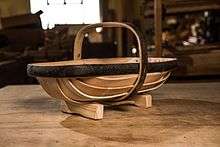Sussex trug
A Sussex trug is a wooden basket. It is made from a handle and rim of coppiced sweet chestnut wood which is hand-cleft then shaved using a drawknife. The body of the trug is made of five or seven thin boards of cricket bat willow, also hand-shaved with a drawknife.[1] They may have originated in Sussex because of the abundance of chestnut coppice and willows found on the marshes. Nails or pins used are usually copper, to avoid rust.

Shapes and sizes became standardised, the most well-known shape being the "common or garden" trug ranging in volume from one pint to a bushel. However, there is a diverse range of traditional trugs from garden and oval trugs to the more specialised "large log" and "walking stick" trugs.[2]
History
Richard Acres worked as a trug maker in 1485, in Rotherfield in Sussex.[3]
Trugs date back to the 1500s,[4] with active trade in Horsham.[5]
Thomas Smith of Herstmonceux, displaying his trugs at the Great Exhibition of 1851, gave the basket wider renown;[4] he was rewarded when Queen Victoria purchased several for members of the Royal family.[6] Further appearances at international exhibitions followed at the 1855 Universal exhibition in Paris; the First International Forestry Exhibition in Edinburgh 1884 and London International Inventions Exhibition.[6]
By the 1970s, Herstmonceux remained as a significant centre of trug production, with four firms operating in or near that village: Greens of Hailsham, R. Reed, R.W. Rich and Sons, and Thomas Smith and Sons.[7]
References
- "Images of trug making". countrylovers.co.uk.
- Image of a "walking stick" trug from thetrugstore.co.uk
- Plea Rolls of the Court of Common Pleas; CP 40/891; reign of Richard III; http://aalt.law.uh.edu/AALT3/R3/CP40no891/aCP40no891fronts/IMG_0171.htm 4th entry, with Kent in the margin
- Henley, Jon (2 October 2009). "How to make a trug". The Guardian. Retrieved 2013-03-11.
- T. P. Hudson, ed. (1986). "A History of the County of Sussex: Volume 6 Part 2: Bramber Rape (North-Western Part) including Horsham". Retrieved 2013-03-11.
Already by the 16th century there were representatives of more specialized trades, reflecting the high social and economic status of many of the town's residents: an armourer, a barber, a cutler, a foyster or maker of saddle trees, a hat dresser, a last maker, a painter, and makers of buckets, pins, points (i.e. fastenings for clothes), scythes, baskets or trugs, and shovels.
- "Sussex Garden Trug". Archived from the original on 19 March 2012. Retrieved 10 March 2012.
- Tuffin, Alison (1971). "The Sussex Trug: An Investigation into the Production of Trugs". Retrieved 2013-03-11.
A study of trug making in Sussex, with particular reference to four firms operating in and around the village of Herstmonceux. The first of nine chapters provides a general introduction, followed by a history of the trug, and its inventor Thomas Smith. Further chapters describe the manufacture of trugs, their sale and usage, the craftsmen who made-make them, mechanisation and its influence on the trug industry, and descriptions of four trugging firms (Greens of Hailsham, R. Reed, R.W. Rich and Sons and Thomas Smith and Sons).
External links
| Wikimedia Commons has media related to Sussex trug basket. |
- Henley, Jon (8 October 2009). "Disappearing acts: Making a trug" (Flash Video). The Guardian.